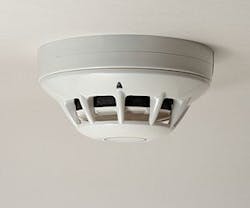How Fire-Detection Systems Work
Fire is one of the most dangerous events possible; somewhere in the world, one occurs every minute of every day. While fire can be our friend in some instances, it can be our worst enemy when it’s uncontrolled and allowed to continue through a building. Fire is, of course, destructive, and the smoke from a fire creates a toxic, dangerous atmosphere. The rapid detection of a fire and its control can save several thousand lives, thousands of injuries, and millions of dollars in property loss each year.
The field of fire detection has advanced to where smoke detectors and alarm devices have combined to become life-safety systems. The purpose of an automatic fire-alarm system is to detect an occurrence, alert the control panel and proper authorities, and notify the occupants to take action.
Current Fire-Detection Systems
The automatic fire-detection system, like any other asset, has a lifespan of 10 to 15 years. After 15 years, it is no longer considered reliable, and there may not be parts available for its repair. The fire-detection system today consists of an FACP (fire alarm control panel) – this is the system’s brain, and it’s capable of making rapid decisions. Detection devices run the gamut, from smoke detectors and heat detectors to multi-capability detectors, which contain a number of functions in one detector. Many of the detectors manufactured today have addressable switches contained in the detector that allow the detector to tell the FACP exactly where the fire is located. The detection devices detect the presence of smoke or particles of combustion and then alert the FACP about a problem; the FACP then decides what action to take.
The FACP may confirm the findings with other area detectors, thereby reducing the potential for nuisance or false alarms. The FACP may activate the audible and visual notification devices, which will alert the building’s occupants to take action. The notification devices may be a loud horn, a flashing strobe light, a bell, a gong, or a loud speaker that announces verbal instructions to the occupants. It may only activate on certain floors of a building. In high-rise occupancies, it’s common to alert on the fire floor, the floor above, and the floor below. This reduces the need to evacuate an entire building. In a hospital or extended-care facility, the FACP may only notify certain people to allow staff to check out the situation and make a decision for general evacuation.
It’s important to note that all fire alarm and detection systems require periodic care and maintenance. Depending on the local AHJ (authority having jurisdiction), there may be requirements for annual, semi-annual, or monthly system testing. Testing must be conducted by competent, well-trained personnel. A properly installed and maintained system saves lives and reduces property damage.
Richard J. Keyworth is president at Keyworth Fire and Safety Consultants Inc., Elk Grove Village, IL.
